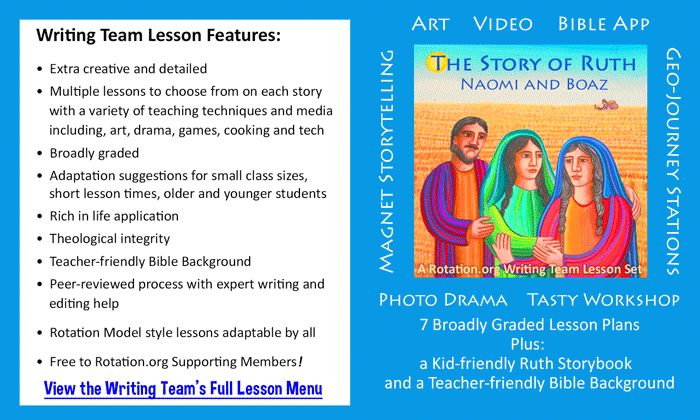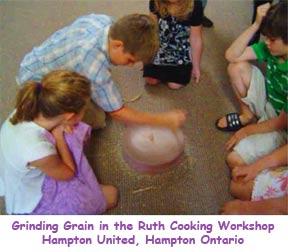The Story of Ruth
Cooking Workshop
Summary of Lesson Activity:
Our mission project involves taking care of those who may not have enough, good food to eat. We are going to make gift jars filled with all the ingredients someone would need to make a nice healthy soup. Cards will also be made to go with each gift jar.
Scripture Reference:
Ruth chapters 1 - 4
Key Verse: ”Remind the people to be subject to rulers and authorities, to be obedient, to be ready to do whatever is good” Titus 3:1 (NIV)
Workshop Objectives
- Learn about the recipient of our mission project.
- Discuss the idea of being obedient to those in authority.
- Discuss the idea of being “ready to do whatever is good”—a part of our memory verse.
Leader Preparation:
- Review Background notes.
- Gather Materials.
Materials List:
- Bibles
- Children’s Bible
- Copy of memory verse written large
- Clean 16 ounce/pint jars -- run them through a dishwasher just before class, to “sterilize” them
- Clean newspaper or table coverings
- Food handling gloves for the students touching food products (one per student)
- Hats or head kerchiefs (one per student)
- Ingredients for the jars -- this will depend on your recipe
- Pre-printed labels for jars
- Bowls to hold the ingredients before they are measured out
- Measuring cups and spoons
- 6 inch squares of fabric or colorful tissue paper (to decorate the lids)
- Ribbon, scissors
- Paper, crayons or markers, stickers and any other items to decorate cards for the gift recipients
- Hole punch
- Recipe for soup creation & ingredients list - print this recipe/ingredient list on a sticker that can be applied to the cards the students will be making (one per jar created)
- CD player and Christian music (Optional)
Advance Preparation:
- Put a notice in the church bulletin asking the congregation for clean, quart-sized jars (with labels removed).
- Determine recipe to make for soup.
- Determine how many jars we want to make, so that we know how many of each ingredient to buy.
- Create stickers with an ingredient list, as well as instructions for how the gift-recepient is to make the soup.
- Pre-print labels for the jars (include info on how made this gift)
- Cut the squares of fabric (or tissue) to decorate the lids (suggestion: use pinking shears for fabric).
- Decide how you will make adjustments for the different ages.
Before the Start of Class:
- Set up the various stations to fill the gift jars. Cover tables with clean newspaper or table coverings.
- Set up the "stations" to fill the jars. There should be one station for each ingredient. Put the ingredient stations in the order that you want them layered in the jars. (Think about the visual appeal of your finished jar, in determining the order of ingredients.)
- Place ingredients for a particular station in a large bowl. Provide the appropriate sized measuring cup for that station. (Depends on your recipe.) There should also be a station to put the labels on the jars. If you have enough students, you may wish to have a station for "card" creation and a station to cover the lid with fabric and tie it on with the ribbon, also attaching the card.
- Have several adults around to help supervise the stations.
- Make sure the students wash their hands when they enter the classroom.
Presentation:
Opening- Welcome and Lesson Introduction
Introduce yourself to the students.
Open with a prayer.
Leader's Note: We would like to have a consistent opening and closing to each class, especially since the teacher and workshop children attend changes each week. Please start the class by having everyone make the sign of the cross and say: “We make our beginning in the name of God the Father—and God the Son—and God the Holy Spirit. Amen.
Dig: Main content and Reflection
Introduction & Bible Story:
Our story for this month has been the story of Ruth. We will find out soon how it ties in to our Sunday School mission project.
Read the story of Ruth from one of our Children’s Bibles. If the story is happening later in the month, you could show the students the pictures from the Children’s Bible and have them tell you the story.
Make sure to touch on why Naomi and her family went from Bethlehem to Moab;
- the marriages and deaths in Moab;
- Ruth insisting that she go back to Bethlehem with Naomi;
- Ruth gleaning in the fields;
- Boaz acting as their kinsman-redeemer and marrying Ruth.
Why did Naomi and her husband and sons travel to Moab? (there was a famine in Bethlehem and they went to Moab to find food). The shortage of food comes in to play later in the story as well.
When Ruth and Naomi returned to Bethlehem, there was no husband to provide for them. So Ruth went out to glean in the fields. Gleaning had something to do with harvest-time. One of God’s laws said that the people harvesting the fields should not go back to pick what they had missed. This leftover grain was to be left for those less fortunate to collect—the poor, the widows, orphans, etc. Ruth and Naomi qualified for this since they were both widows.
Our mission project involves taking care of those who may not have enough good food to eat. We are going to make gift jars filled with all the ingredients someone would need to make a nice healthy soup. All they have to do is add boiling water.
Give the students some information on the agency that we will be giving the soup jars to for their clients.
Activities: Create Gift Jars - Ruth and Boaz: “ready to do whatever is good”
Start the “assembly line.”
- Assign one or two students (depending on class size and number of stations) to each station.
- The students should put on the plastic gloves before they start handling the food.
- Tell the students that we are trying to put the ingredients into the jars in layers, so they should not stir or shake the jars as they filling them or handing them to the next station.
- If you would like, you could have a Christian CD playing in the background.
Making cards
Make cards for the people that will be receiving the gift jars. Supply them with paper, crayons, markers, stickers, etc. (The early-arrivers could do this while waiting for class to start; it could also be done if you have time left over at the end.) Hole punch these cards and attach them to the lid with the ribbon.
Reflect/Closure:
Review the memory verse: "Remind the people to be subject to rulers and authorities, to be obedient, to be ready to do whatever is good." Titus 3:1
In our story, Ruth was obedient to her mother-in-law Naomi; and Boaz was obedient to the Jewish laws about taking care of his family members.
How were Ruth and Boaz “ready to do whatever is good”?
How are you obedient to those in charge of you?
How are you “ready to do whatever is good”? (hopefully, someone will mention the mission project).
Closing Prayer:
We would like to have a consistent opening and closing to each class, especially since the teacher and station changes each week. Please end the class with the benediction from Numbers 6: 24-26 (CEV). Make the sign of the cross and say:
I pray that the LORD will bless and protect you, and that He will show you mercy and kindness. May the LORD be good to you and give you peace. Amen.
Age Adaptations
Older students: May need to help younger students in the assembly line.
Younger students: Some of the students may need help with the assembly line.
PreSchool students: May need to pair them up with an older child or adult during the assembly line of ingredients.
Workshop Review by Cathy:
When we did this workshop we made 48 jars, which took about 30 minutes to do. We had the younger students (preschool up to early primary grades) sit at the table and spoon out the ingredients. Some of the older students went down the line holding the jar while the younger students put their ingredients in. Some of the other older students put the labels on and put the lids on.
Our jars were filled with rice and various herbs and dried vegetables, to make a rice dish (our recipe had 8 or 9 ingredients). We wanted something with a grain-type food to fit in with the gleaning part of the story.
I was so pleased with how the kids did. We had several 3 and 4 year olds, and some older kids with special needs/trouble staying focused. They sat at their spots and patiently dished out ingredients for the 48 jars.
A lesson written by Cathy Walz from: St. John Lutheran Church
Forest Park, IL
A representative of Rotation.org reformatted this post to improve readability.




 (bless be the creme filling that binds)
(bless be the creme filling that binds)
